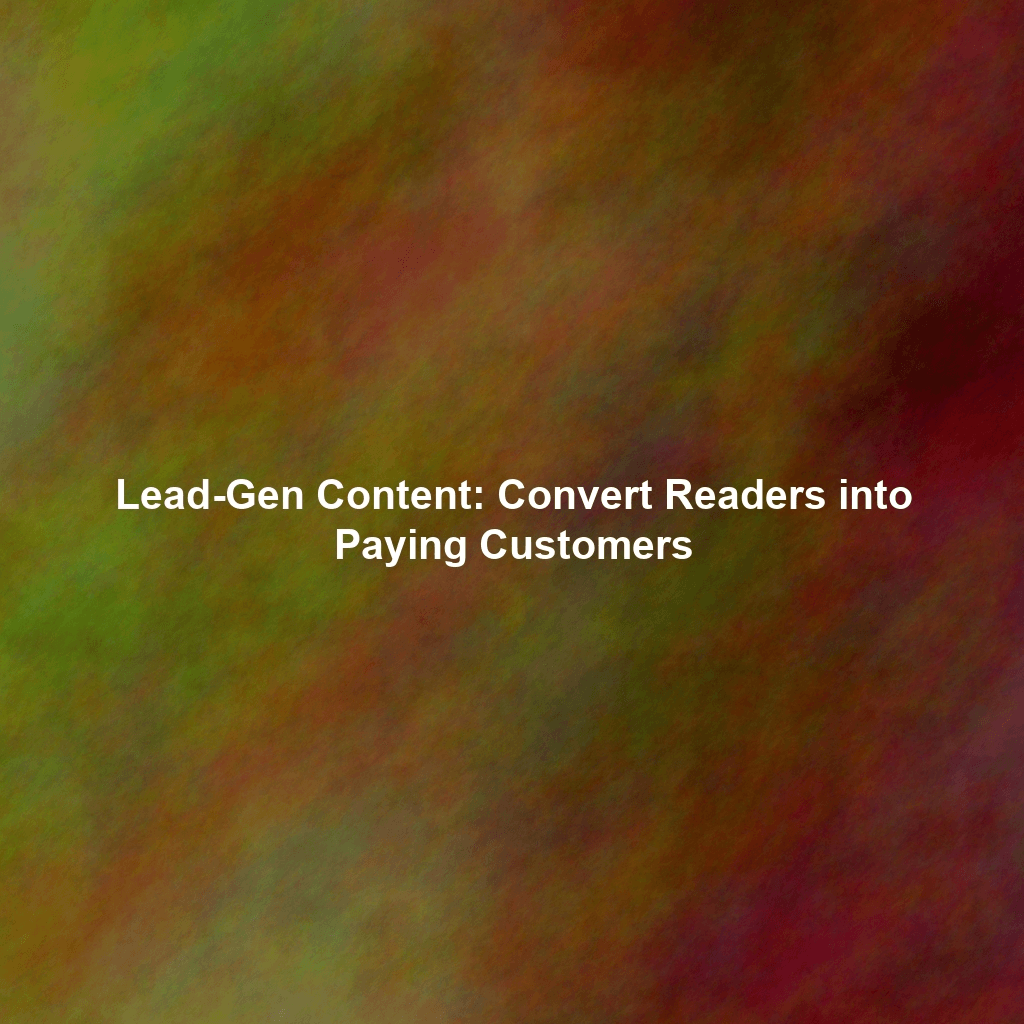Turning Content into a Lead-Generating Machine
Know Your Audience: The Foundation of Lead-Generating Content
Before you even think about writing a single word, you need to deeply understand your audience. Who are they? What are their pain points? What are their aspirations? What information are they actively seeking?
Creating Buyer Personas
Buyer personas are semi-fictional representations of your ideal customers. They provide a detailed picture of your target audience, including their demographics, motivations, behaviors, and goals. To create effective buyer personas:
- Conduct thorough research: Analyze your existing customer data, conduct surveys, and interview your sales and customer support teams.
- Identify common traits: Look for patterns and similarities in your research to identify key characteristics of your ideal customers.
- Give them names and backgrounds: Humanize your personas by giving them names, occupations, and backstories. This will help you empathize with them and understand their needs.
- Document their pain points and challenges: What problems are they trying to solve? What are their biggest obstacles?
- Understand their goals and aspirations: What are they hoping to achieve? What are their dreams and ambitions?
Once you have well-defined buyer personas, you can tailor your content to address their specific needs and interests. This will make your content more relevant, engaging, and ultimately more effective at generating leads.
Mapping Content to the Buyer’s Journey: A Strategic Approach
The buyer’s journey is the process that potential customers go through from awareness to purchase. Understanding this journey is crucial for creating content that resonates with your audience at each stage.
The Stages of the Buyer’s Journey
- Awareness Stage: The prospect realizes they have a problem or need.
- Consideration Stage: The prospect researches potential solutions to their problem.
- Decision Stage: The prospect compares different solutions and chooses the best one for them.
Content for Each Stage
- Awareness Stage Content: Focus on educating your audience about their problem and the potential solutions.
Examples: Blog posts, infographics, social media updates, ebooks that address the problem and its impact. Focus on general information and avoid overtly promotional content. Keywords at this stage should be broad and related to the problem itself. - Consideration Stage Content: Provide more in-depth information about your solution and how it can help solve their problem.
Examples: Case studies, white papers, webinars, comparison guides. Content should showcase the benefits of your solution and how it compares to alternatives. Use more specific keywords related to different solution approaches. - Decision Stage Content: Focus on convincing the prospect that your solution is the best choice for them.
Examples: Product demos, free trials, testimonials, pricing pages. Content should highlight the unique features and benefits of your product or service and address any remaining concerns. Keywords at this stage can include branded terms and specific product features.
By creating content that aligns with each stage of the buyer’s journey, you can effectively guide prospects through the sales funnel and increase your chances of converting them into customers.
Creating Irresistible Lead Magnets: The Bait That Attracts
A lead magnet is a valuable resource that you offer to prospects in exchange for their contact information. It’s a crucial tool for building your email list and generating qualified leads.
Characteristics of a Great Lead Magnet
- High Value: It should provide tangible value to the prospect and address a specific pain point.
- Relevance: It should be highly relevant to your target audience and their interests.
- Actionable: It should provide practical tips and advice that prospects can implement immediately.
- Easy to Consume: It should be easy to read, understand, and use.
- Immediate Gratification: It should deliver immediate results or benefits.
Types of Lead Magnets
- Ebooks: Comprehensive guides on a specific topic.
- Checklists: Step-by-step guides for completing a specific task.
- Templates: Pre-designed documents or tools that prospects can customize.
- Webinars: Online presentations or workshops.
- Free Trials: Access to your product or service for a limited time.
- Quizzes/Assessments: Interactive tools that provide personalized feedback.
- Discount Codes: Exclusive discounts on your products or services.
When creating a lead magnet, focus on providing exceptional value and making it easy for prospects to access it. This will increase your conversion rates and generate more qualified leads.
Optimizing Content for SEO: Getting Found by Your Audience
Creating great content is only half the battle. You also need to optimize it for search engines so that your target audience can find it. Search Engine Optimization (SEO) is the process of improving your website’s ranking in search engine results pages (SERPs).
Key SEO Strategies for Content
- Keyword Research: Identify the keywords that your target audience is using to search for information related to your business. Use tools like Google Keyword Planner, SEMrush, or Ahrefs.
- On-Page Optimization: Optimize your content for your target keywords by including them in your title tags, meta descriptions, headings, and body text.
- High-Quality Content: Create content that is informative, engaging, and valuable to your audience. Google prioritizes high-quality content that provides a good user experience.
- Internal Linking: Link to other relevant pages on your website to improve navigation and SEO.
- External Linking: Link to authoritative websites to add credibility to your content.
- Mobile Optimization: Ensure that your website is mobile-friendly, as Google prioritizes mobile-first indexing.
- Page Speed: Optimize your website’s loading speed to improve user experience and SEO.
By implementing these SEO strategies, you can improve your website’s visibility in search engine results and attract more organic traffic to your content. Don’t just stuff keywords, focus on naturally incorporating them into valuable content.
Crafting Compelling Calls to Action (CTAs): Guiding Your Audience
A call to action (CTA) is a prompt that encourages your audience to take a specific action, such as downloading a lead magnet, signing up for a webinar, or requesting a demo. CTAs are essential for converting content consumers into leads.
Elements of an Effective CTA
- Clear and Concise: Use clear and concise language that tells the prospect exactly what you want them to do.
- Action-Oriented: Use action verbs that encourage the prospect to take action. Examples: “Download Now,” “Sign Up Today,” “Get Started.”
- Visually Appealing: Make your CTAs stand out visually by using contrasting colors and compelling graphics.
- Urgency and Scarcity: Create a sense of urgency and scarcity to encourage prospects to take action immediately. Examples: “Limited Time Offer,” “Only a Few Spots Left.”
- Relevance: Ensure that your CTAs are relevant to the content that the prospect is consuming.
Placement of CTAs
- Within the Content: Embed CTAs within the body of your content to capture the attention of readers as they are consuming the information.
- At the End of the Content: Place CTAs at the end of your content to encourage prospects to take action after they have finished reading.
- Pop-Ups: Use pop-up CTAs to grab the attention of visitors as they are browsing your website (use these sparingly and thoughtfully to avoid frustrating users).
- Sidebar: Display CTAs in the sidebar of your website for easy access.
By crafting compelling CTAs and strategically placing them throughout your content, you can significantly increase your lead generation rates.
Promoting Your Content: Getting it Seen by the Right People
Even the best content won’t generate leads if no one sees it. Content promotion is crucial for increasing the visibility of your content and driving traffic to your website.
Content Promotion Strategies
- Social Media: Share your content on social media platforms and engage with your audience.
- Email Marketing: Send email newsletters to your subscribers with links to your latest content.
- Guest Blogging: Publish guest posts on other websites in your industry to reach a wider audience.
- Influencer Marketing: Partner with influencers to promote your content to their followers.
- Paid Advertising: Use paid advertising platforms like Google Ads and social media ads to drive traffic to your content.
- Content Syndication: Republish your content on other websites to reach a larger audience.
Develop a content promotion plan that includes a mix of these strategies to maximize the reach of your content and generate more leads.
Analyzing and Optimizing Your Content: Continuous Improvement
Content marketing is an ongoing process. You need to continuously analyze your results and optimize your strategies to improve your lead generation rates.
Key Metrics to Track
- Website Traffic: Track the number of visitors to your website and the sources of your traffic.
- Lead Generation Rate: Track the percentage of website visitors who become leads.
- Conversion Rate: Track the percentage of leads who become customers.
- Engagement Metrics: Track metrics like time on page, bounce rate, and social shares to measure the engagement of your content.
- SEO Rankings: Track your website’s ranking in search engine results for your target keywords.
Tools for Analysis
- Google Analytics: Track website traffic, user behavior, and conversion rates.
- Google Search Console: Monitor your website’s performance in Google search results.
- Social Media Analytics: Track engagement metrics and reach on social media platforms.
- Marketing Automation Platforms: Track lead generation, conversion rates, and email marketing performance.
By analyzing your results and optimizing your strategies, you can continuously improve your content marketing performance and generate more leads over time.
From Content Creation to Lead Conversion: A Winning Strategy
Creating content that generates leads is a strategic and multifaceted process. It requires a deep understanding of your audience, a well-defined content strategy, compelling lead magnets, effective SEO, and strategic promotion. By implementing the strategies outlined in this article, you can transform your content into a powerful lead-generating machine and fuel the growth of your business. Remember to focus on providing value, building relationships, and continuously optimizing your approach. The results will speak for themselves.
“`
 Skip to content
Skip to content

